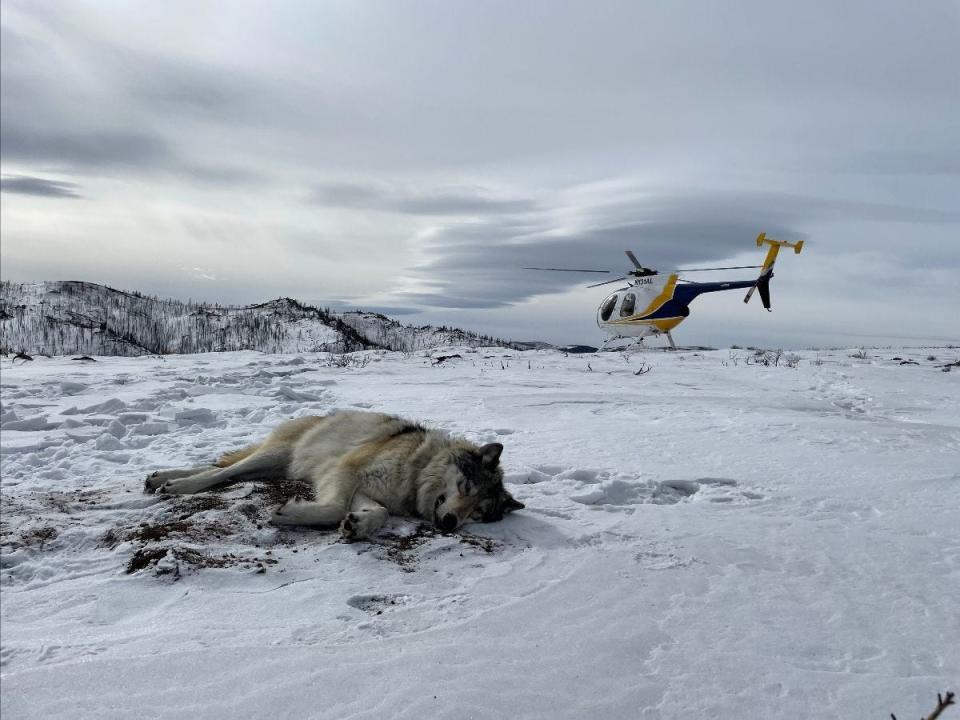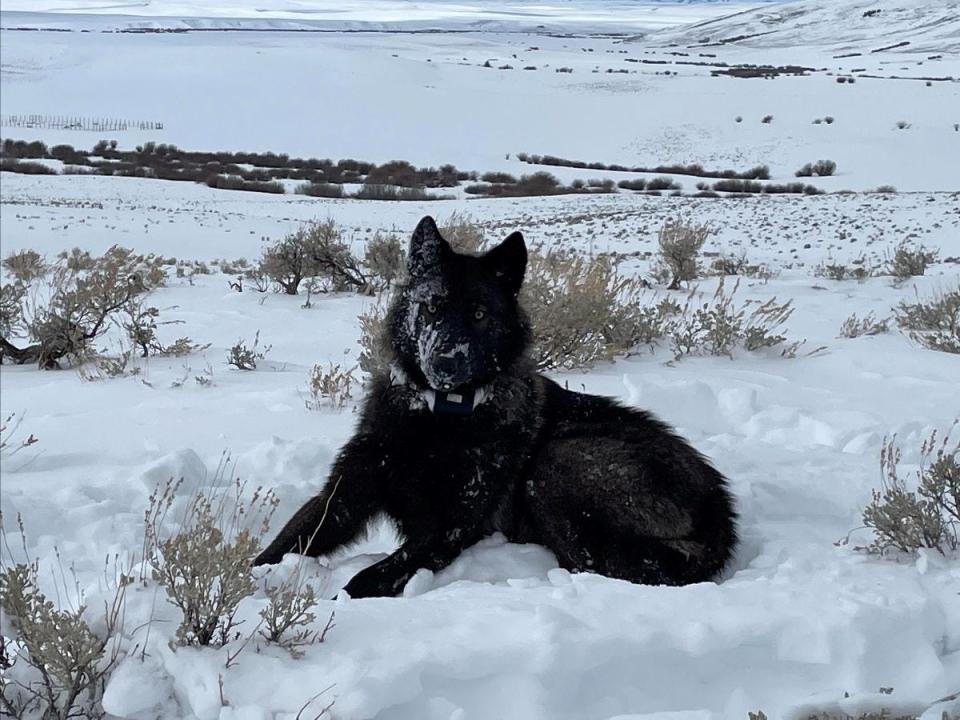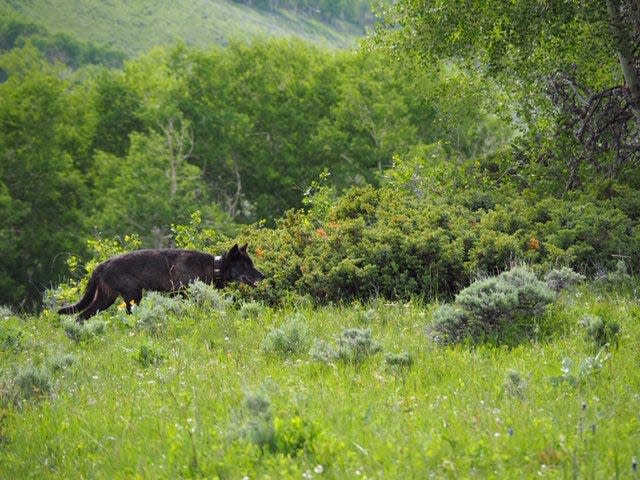Colorado wolfpack no longer has working collars, causing concern among officials
Colorado's closely watched North Park wolfpack no longer has a working radio collar among its members, causing growing concern among ranchers, some wolf experts and the state wildlife agency.
Colorado Parks and Wildlife confirmed to the Coloradoan the remaining working collar among the three fitted on pack members failed May 13. That collar was attached to the breeding adult male of the pack, which last year helped produce the state's fist pups in 80 years.
"Not having a functional collar in the pack makes it very difficult to have up-to-date information on where the pack is,'' the state wildlife agency wrote in an email response to Coloradoan questions.
Rancher Don Gittleson, who has suffered the vast majority of depredations by the wolfpack, said the collars allowed Colorado Parks and Wildlife to tell him where the wolves had been. He said collars also aid wildlife officials in confirming wolf kills on cattle by identifying where wolves were at the time of the kills.
"Collars were the only way CPW could keep track of the wolves, so without the collars they are blind,'' said Gittleson, whose 11,000-acre ranch he leases northeast of Walden has been home to four of the state's five confirmed wolf kills of cattle.

Colorado wolf reintroduction: Where predator will be released a thorny issue
How radio collars help biologists keep track of wolves in Colorado
GPS collars work by collecting location points at a predetermined interval and then sending the data via satellite to wildlife biologists, the wildlife agency said. Collars do not allow biologists to know exactly where the wolves are in real time. Staff can view the location data every few days to determine where wolves have been.
Very high frequency (VHF) technology emits detectable radio frequencies and allows animals to be located in the field by staff on the ground or in the air.
Colorado Parks and Wildlife captured and fitted the male wolf, which is presumed to have migrated from Wyoming, with a new collar in February 2021. In February of this year, CPW captured and collared one of the pack's yearling females. Both collars included GPS (satellite) and VHF (radio) technology that now have failed for unknown reasons, the agency said.
The batteries on the collars have a lifespan of five years.
The pack's breeding female was originally fitted with a VHF collar in Wyoming's Grand Teton National Park in 2017. The collar failed last year, which prompted wildlife officials to collar another member of the pack, which was the yearling female.

State wildlife officials said the male's collar quit providing data May 13, which was within the window of when the female would have selected a den to have pups. However, there has been no evidence of breeding this year.
"Because the male's radio collar locations did not demonstrate any localization, we are fairly confident that there was no denning occurring this spring,'' the agency wrote.
After giving birth to six pups last year, all of which survived, the adult female has not been seen since Feb. 13, when Gittleson said he saw her on his ranch. Also, the den she used last year was not used this year.
It is unknown if the 6-year-old female is alive.
There have been few sightings of the pack in recent weeks, though a trail camera on Gittleson's ranch captured an image of a wolf, presumed to be the pack's 5-year-old adult male, on his property about 9 a.m. Thursday.
Carter Niemeyer spent three decades studying, killing and trapping gray wolves for the federal government before retiring. He now works with ranchers on how to coexist with wolves and sits on the Colorado Parks and Wildlife's Gray Wolf Reintroduction Technical Working Group.
He believes this is an ideal time to trap wolves for two reasons. He said using leghold traps would serve as a "spank and release'' to scare wolves away from cattle while allowing the capture of a wolf to be fitted with a collar.
"It's a no-brainer to me that you would want a radio collar on one of them, especially when they are visible and visiting the ranches,'' he said. "There is tremendous value to know where the wolves are because it helps ranchers know where to put their nonlethal effort to deter wolves. Trapping is a nonlethal method of harassment that works well to scare wolves, and that buys the rancher more time, which is what they need right now.''
Leghold traps were banned by voters in 1996. It us unclear if the use of those traps would be permitted.

Collision course: North Park calving season collides with wolf births
Radio collars help calm 'nerves' of people wanting to know where the wolves are
Diane Boyd, who spent four decades studying wolves, served as the large carnivore specialist for Montana Fish, Wildlife and Parks before retiring.
She said radio collars are not the only way to keep tabs on wolves.
"Right now they should have trail cameras out and do howling to help settle what might have happened to her and the other wolves,'' said Boyd, who added that the average life expectancy of Rocky Mountain wolves is 4.5 years. "If there are pups, they will respond to howling.''
Colorado Parks and Wildlife wrote field biologists rely on observations such as signs of tracks and scat to confirm wolf sightings.
Collars contain a mortality signal that activates when an animal has not moved for a period of time. But the collar has to be functioning for the signal to be transmitted.
Ed Bangs, who oversaw the U.S. Fish and Wildlife Service's gray wolf recovery program in the Northern Rocky Mountains before retiring in 2011, said using helicopters to capture and collar wolves this time of year is not ideal. He said the heat of summer stresses the animals, and vegetation makes it difficult to find wolves.
"The need to radio collar is because people get nervous not knowing where the animals are,'' said Bangs, who in the latter part of his career voiced concerns about using radio collars on wolves. "I understand why people on both sides of the wolf issue want to know where they are, and collars help do that, but you have to find them first.''
Colorado Parks and Wildlife, which is partnering with lead agency U.S. Fish and Wildlife Service in managing wolves, said it does not plan to capture and collar wolves at this time.
The U.S. Fish and Wildlife responded Tuesday afternoon to questions the Coloradoan sent June 13 and Wednesday writing that it does not have plans to collar North Park wolves at this time and strongly recommend aerial capture only take place in winter.
Colorado Parks and Wildlife expects to collar many of the wolves in the early stages of reintroduction, which is scheduled to take place by the end of next year, before tapering off collar use.
Colorado wolf reintroduction: Opposing sides see delay
How to report a wolf sighting
Colorado Parks and Wildlife urges people to contact the agency immediately and fill out a report if they see or hear wolves or find evidence of wolf activity in Colorado. The Wolf Sighting Form can be found at cpw.state.co.us/learn/Pages/Wolf-Sighting-Form.aspx.
Reporter Miles Blumhardt looks for stories that impact your life. Be it news, outdoors, sports — you name it, he wants to report it. Have a story idea? Contact him at milesblumhardt@coloradoan.com or on Twitter @MilesBlumhardt. Support his work and that of other Coloradoan journalists by purchasing a digital subscription today.
This article originally appeared on Fort Collins Coloradoan: Colorado wolfpack has no working tracking collars, officials 'blind'

